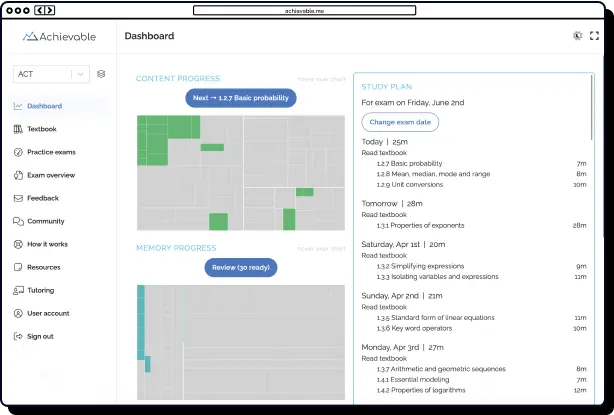
GRE math hacks to boost speed and accuracy





Clay Daniel is the founder of Clayborne Test Prep and Tutoring, a Charlottesville-based company offering college and graduate school entrance exam preparation, personalized tutoring, and organizational coaching. A graduate of Harvard University and Dallas Theological Seminary, Clay brings over 15 years of experience in education and test preparation, with near-perfect scores on numerous standardized exams. He has also served as a question editor for the Classic Learning Test (CLT), an undergraduate admissions exam rooted in classical education. Through Clayborne, Clay is dedicated to expanding access to high-quality test preparation, helping thousands of students build brighter academic futures.
Table of contents
- Approaching GRE quantitative comparison: Strategies and examples
- Key insights
- Save time by comparing, not calculating
- Use common triangle types for speed and accuracy
- Plug in values strategically for variable-based problems
- Be strategic with answer choice “D”
- Conclusion: Pattern recognition and strategic thinking drive success
Approaching GRE quantitative comparison: Strategies and examples
Key insights
- The GRE rewards reasoning and insight. Mental estimation and strategic comparison often yield correct answers faster than detailed computation.
- Mastery of 30-60-90 and 45-45-90 triangles transforms geometry from laborious calculation to rapid, confident problem-solving on the GRE.
- Strategic plugging, deliberately substituting boundary values, offers a practical lens to clarify the underlying structure of an algebraic problem.
- Recognizing when, and how, to “hunt for D” can be crucial for test-takers aiming for greater precision and efficiency.
Many students feel anxious when they encounter quantitative comparison (QC) questions on the GRE, even if they’re comfortable with other types of math problems. This reaction is understandable. QC questions don’t just check your arithmetic, they challenge your ability to spot relationships and recognize patterns quickly under time constraints.
Instead of pushing you to find one final answer, QC questions ask you to judge whether one quantity is larger, smaller, equal to another, or if there isn’t enough information to decide. That means you’ll need to rely more on logic, quick estimation, and efficient decision-making than lengthy calculation. Because these problems are a significant part of the GRE quant section, mastering QC can have a major impact on your overall score.
Here are practical strategies and key mindsets to help you face these unique GRE questions confidently.
Save time by comparing, not calculating
Solving every problem down to the final decimal isn’t necessary. On the GRE, using comparison and estimation often conserves both time and energy.
Take this example: if the two algebraic quantities are Quantity A: (2x + 3) and Quantity B: (2x + 5) with real (x), it’s immediately clear that Quantity B is always greater. You don’t need to plug in values or do extra algebra. In geometry, if you’re comparing shapes with similar properties, focusing on their distinct elements can be more efficient than calculating all individual areas.
Research from ETS and leading test prep companies shows that successful test-takers work through GRE quant questions in just 1 - 2 minutes by using comparison, estimation, and recognizing patterns. Practicing these skills helps minimize fatigue and makes your approach more flexible during the test.
Many believe that detailed calculations offer more security on test day. In reality, though, GRE quant problems are designed to reward strategic thinking over exhausting computation. Learning to spot when a quick comparison is enough is a key skill.
Use common triangle types for speed and accuracy
In GRE geometry, two right triangles come up repeatedly: the 45-45-90 and the 30-60-90 triangles. Knowing their properties lets you work faster and make more confident choices.
- 45-45-90 triangle: Sides are in a 1:1:√2 ratio. This triangle appears when a square is cut diagonally.
- 30-60-90 triangle: Sides are in a 1:√3:2 ratio. It often shows up in halved equilateral triangles.
Whether identified directly in a question or hidden within a larger figure, these triangles are everywhere. For instance, when a problem features a square’s diagonal, remembering that it’s the side times √2 means you don’t have to use the Pythagorean theorem from scratch. Many GRE geometry problems are based around these triangles.
Work at spotting these structures early. Instead of calculating side lengths every time, use your knowledge of their ratios right away. This habit boosts both speed and accuracy so you can dedicate your attention where it’s needed most.
Plug in values strategically for variable-based problems
When you see expressions with variables, especially in QC or inequality questions, try substituting boundary or strategic values instead of working out an abstract solution.
For instance, consider: Is (a^2 > a) for all real numbers (a)? Test out a few values:
- (a = 0): (0^2 = 0); so, not true here.
- (a = 1): (1^2 = 1); still equal.
- (a = -1): ((-1)^2 = 1), which is greater than -1.
Trying different categories (zero, positive one, negatives, fractions) helps you uncover exceptions or confirm if a statement always applies. This saves valuable time and helps you avoid falling into common GRE traps.
Besides plugging in, also look for possible ways to simplify or factor expressions. If you’re comparing (x^2 + 2x) to (2x + x), notice that (2x + x) simplifies to (3x). Knowing this makes the comparison much more manageable.
Be strategic with answer choice “D”
On QC questions, choice “D” means: “The relationship cannot be determined from the information given.” Deciding when to pick “D,” and not just using it as a fallback, sets top scorers apart.
Use this approach: If trying out several different values gives different comparative outcomes (sometimes Quantity A wins, sometimes Quantity B) then “D” is your answer. This shows that the relationship changes depending on the numbers.
Don’t choose “D” only because a question feels difficult, or after just one unsuccessful attempt. Test multiple reasonable cases or scenarios before settling on “D.” Careful checking keeps you from jumping to conclusions.
Think of “D” as an option that requires proof, not a default whenever you’re in doubt. It should spur you to try edge cases and examine the boundaries of each question.
Conclusion: Pattern recognition and strategic thinking drive success
Success on the GRE quantitative reasoning section isn’t about endless calculation. What truly matters are the strategies you apply and your ability to adapt as needed. Focus on:
- Using comparison in place of direct calculation when you can
- Recognizing key right triangle properties and ratios
- Plugging in smart values to clarify variable-based questions
- Identifying when choosing answer “D” is truly justified
Building these habits will accelerate your process, reduce errors, and raise your confidence on exam day. Structure your practice around techniques like strategic substitution, mental estimation, and visual pattern spotting. With consistent effort, even the hardest GRE quant problems will become more manageable. These strategies not only lead to better scores: they also nurture a flexible, insightful mindset for future mathematical challenges.

